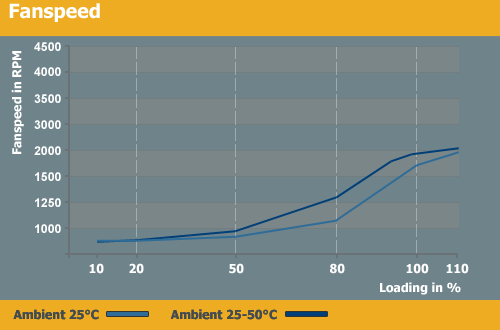Cooler Master UCP 900W
by Christoph Katzer on July 29, 2008 3:00 AM EST- Posted in
- Cases/Cooling/PSUs
Temperatures, Fan Speed, and Acoustics

The two heatsinks remain at reasonable temperatures throughout testing. We've seen much worse results with other power supplies topping out at up to 90°C, so the worst result of ~54°C on the secondary heatsink is quite good. It reaches this point at about an 80% load, and then the fan speed increases and temperatures remain static up to 110% load. This indicates that everything is working properly and there shouldn't be any problems with long-term use of the power supply, and even if it's running at closer to 100% load.

The fan spins at a relatively slow 860RPM up to a load of 300W, at which point it begins to spin faster. It's at 1100RPM at 80% load (720W), and it no longer qualifies as a quiet PSU. Beyond 80% load, fan speed increases rapidly up to the maximum 2000RPM, keeping things cool as we have seen in the temperature graph, but your ears might not be as happy....

If your goal is to have a quiet or near-silent power supply, you will want to keep this PSU under 500W of load. Once we pass 700W, noise levels increase rapidly from 20dB(A) up to a maximum 31dB(A). Given the relatively tame temperatures, Cooler Master certainly could have lowered fan speeds and noise levels more, as the heat sinks are usually in the 40-50°C range. However, we won't complain too much as it will be quite difficult for most users to come anywhere near 100% load (or even 80% load) on this power supply.










33 Comments
View All Comments
MrOblivious - Tuesday, July 29, 2008 - link
Sorry meant to say seems to be indicated in the article in my last line.Adamantine - Tuesday, July 29, 2008 - link
There are four 12v rails, yet you only show regulation on a single rail, not even labeled at that... where are the voltage regulation line graphs for the other 3 rails, if there are in fact 4 rails?jonnyGURU - Tuesday, July 29, 2008 - link
+12V rails are rarely independent. Usually "multiple" +12V rails is just a +12V rail split up into four, six, etc. with an over current protection circuit in place for each. If there's any "regulation" difference between one +12V rail and another, it's usually caused by resistance between the +12V source and the end of the connector and NOT actual poor voltage regulation. So the best course of action would actually be to average out the results or combine +12V rails into one.More on "multiple" +12V rails: http://forums.anandtech.com/messageview.aspx?catid...">http://forums.anandtech.com/messageview.aspx?catid...
Christoph Katzer - Tuesday, July 29, 2008 - link
ehm we combined them into one graph, that's why they are so thick ;) The graph shows in which area all of the rails have been regulated. We had shown differently before but with six rails for example you cant see anything anymore...SilthDraeth - Tuesday, July 29, 2008 - link
I read the review and I saw you nitpick about a few things, but I didn't read about any real problem.JarredWalton - Tuesday, July 29, 2008 - link
The 12V rail problem is that 12V1 (rated at 25A) supplies the power for the 24-pin connector, the 4-pin ATX12V connector, and all the SATA and Molex connectors. Meanwhile, 12V2 *only* powers the EPS12V connector (which quite a few people won't even use!), and 12V3 and 12V4 are dedicated to the PEG connectors.Basically, there's a lot of stuff coming off of the main 12V rail, and thus it's going to be virtually impossible to come anywhere near the rated output unless you happen to have an EPS12V connector on your motherboard. More important is that with the right combination of hardware (i.e. quad-core overclocked CPU, a high-end GPU, and several HDDs) you could easily overload 12V1.
strikeback03 - Wednesday, July 30, 2008 - link
The EPS12V is the 8-pin CPU connector, correct? The same one that seems to be far more common these days on the class of motherboards likely to be used with a 900W PSU than the 4-pin connector?JarredWalton - Wednesday, July 30, 2008 - link
I don't know that I would call EPS12V "common". It's used on some high-end mobos, but not on others. It was initially more of a workstation/server connector. Some PSUs have a 4/8-pin cable that works with either ATX12V or EPS12V, but it seems Cooler Master decided to go with a dedicated ATX12V and a dedicated EPS12V. It would have made a lot more sense IMO if they had all of the peripherals on the same rail as the EPS12V (and ATX12V for that matter).Bozo Galora - Tuesday, July 29, 2008 - link
Weren't you going to add ripple and noise tests?Or do I have the wrong recollection?
These guys say it had 78mv on 12V line
http://www.techpowerup.com/reviews/CoolerMaster/UC...">http://www.techpowerup.com/reviews/CoolerMaster/UC...
Amart - Tuesday, July 29, 2008 - link
Anandtech are not interested in presenting a complete professional review of PSU's, instead they have stated we should "trust them" on ripple and noise questions.I think that Anandtech PSU reviews should look at JonnyGuru.com and HardOcp.com and take notes on how to do things right.